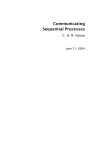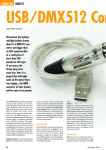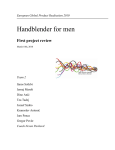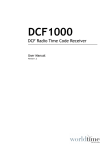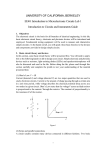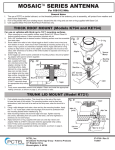Transcript
READERS’ CORNER P.O.Box 190 We can only answer questions or remarks of general interest to our readers, concerning projects not older than two years and published in Elektor Electronics. In view of the amount of post and email received, it is not possible to answer all correspondence, and we are unable to respond to individual wishes and requests for modifications to, or additional information about, Elektor Electronics projects. Capacitor ESR Tester Dear Editor — I have built this circuit from the article in your September 2002 issue and the instrument seems to work as described. In the section about adjusting the instrument, you say that an accurate voltage source of less than 200 mV is required for the adjustment of P5. However being a hobbyist on a limited budget I do not have access to precision test instruments of the kind that’s likely to supply or indeed measure such a voltage. Can you indicate how I should proceed? I was thinking along the lines of a low-impedance potential divider (100 ohms to 1 ohm). I was hoping to use the ESR Tester to locate faulty capacitors in a number of valve radios I am in the process of restoring to their former glory. M. Faulkner An excellent idea — use new technology to restore the old! Leaky capacitors are a common source of problems in vintage radios. Regarding the 200-mV test voltage, your own suggestion is usable in principle: 0.2 V is obtained from 20 V by means of a 100:1 potential divider. The divider may also be dimensioned for a higher impedance, the aim is not so much a stable voltage, but to get the LCD to indicate the same voltage as a reasonably accurate DVM. Hard Disk Interface for the Printer Port Dear Editor — when I run the program I2L4.exe mentioned in the article (January 2002) under plain DOS, I am treated to the following error message: Parallel Port: 0378 – I2L-adapter detected Congratulations, the interface you have built is working properly. The problem is not the hardware but the partitioning of the hard disk. The DOS version of the driver is only capable of accessing disks using a FAT16 partition. By contrast, the Windows version will happily talk to FAT32 disks as well. Year Volume 2002 CD-ROM Mr. Finch of Aylesbury kindly advised us that at least two articles on the Elektor 2002 CD-ROM could not be opened from the archive program. In these cases a different article is opened. The problem is caused by incorrect links in the article database. However, the relevant articles are contained on the CD-ROM and may be opened (using Acrobat Reader) by selecting the file n[production number].pdf found in the folder Articles/N on the CD-ROM. Crescendo Millennium Edition Dear Editor — I have a query on the Crescendo Millennium Edition published in the April 2001 issue of your magazine. I am measuring a direct voltage of –5 volts at the amplifier output. In an attempt to eliminate this voltage, I replaced the 2SK792 by a 2SK537, unfortunately, to no avail. I now suspect that the problem is caused by the MJE340 and MJE350. Since the hFE specs of these two transistors are different, I started to search for a matched pair. I telephoned a number of suppliers only to be told I had to come up with a different type number before a matched pair could be ordered. Do you have suitable type numbers for me? M. Kenyon HDD: xtor 82560A4 Error: unsupported partition type Whatever type of hard disk I attempt to use, the program detects the interface and the HD, but the combination remains useless. Am I missing something (I think I have it all properly connected up)? F.D. Burgess 7-8/2003 offset voltage, a likely source is major differences between the input transistors. If you measure at the output of opamp IC1, very likely you will see almost the supply voltage of +20 V. If so, try better matched input transistors, or modify the offset control — lower R4 and R5 to 1 MΩ and increase C3 to 330 nF. The amplifier output should then stabilise at 0 V. It is by no means necessary to replace the MJE340/350 pair by other types. With complementary transistors there is always a difference in their exact hFE specification. In audio amplifiers, that difference is typically compensated by the overall feedback. You need to look deeper into the circuit to find what’s causing the Elektor Electronics USB Audio Codec Dear Editor — congratulations on the publication of projects that can be connected to the USB bus, these prove that Elektor is miles ahead of your competitor EPE which seems stuck somewhere in the late 1980’s as far as the technology of most of their projects is concerned. I would like to build he USB Audio Codec (December 2002) but modified with a coaxial S/PDIF input. Can I simply replace the TosLink input on the card by a cinch socket and a 75-Ω terminating resistor? Also, in view of this modification, I would prefer to build the circuit on veroboard, do you think that will work? Finally, a question about the copybit. I would like to use the card to copy a number of recordings on DCC cassette to CD, using my PC. Will I be able to transfer private recordings made using the analogue input on my DCC player? J. Grymonprez No, a 75-Ω resistor only is not sufficient for the purpose. You are referred to the article ‘Optoto-Coaxial Audio Converter’ published in the April 1997 issue. There is no reason why the circuit would not work when built on veroboard, provided the component placement does not differ too much from that on the PCB we designed. The recording activities you describe should not cause problems. The UK Terrorism Act 2000 says: “Section 58. - (1) A person commits an offence if (a) he collects or makes a record of information of a kind likely to be useful to a person committing or preparing an act of terrorism, or (b) he possesses a document or record containing information of that kind. (2) In this section “record” includes a photographic or electronic record. (3) It is a defence for a person charged with an offence under this section to prove that he had a reasonable excuse for his action or possession. (4) A person guilty of an offence under this section shall be liable(a) on conviction on indictment, to imprisonment for a term not exceeding 10 years, to a fine or to both, or (b) on summary conviction, to imprisonment for a term not exceeding six months, to a fine not exceeding the statutory maximum or to both. “ Clearly, an accurate long-term timer is invaluable to someone planting a bomb such as the one that blew up the Conservative Party conference in Brighton some years ago. The “reasonable excuse” defence might be enough to get us all off, of course....... M. Thomas Thanks for the information, we are indeed amused rather than impressed. An interpretation of the law as suggested by you could equally be construed to apply to the makers and owners of - Mechanical alarm clocks - Batteries - GSM phones - Electricity - A Tourist Map of Brighton (with the Pier struck off) Week/Month Timer By law the designers should have paperwork describing these products, plus the owners will have some kind of user manual. Should these products be banned and their designers and owners asked to file “reasonable excuses”? we think not. Dear Editor — You will perhaps be amused to know that this article (April 2003) potentially makes your readers liable to 10 years in prison in the UK! Mr. Thomas replied: I agree entirely. I have a shelf of pilot’s manuals and the address of the Houses of Parliament ... 113

